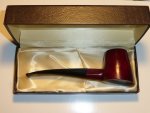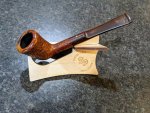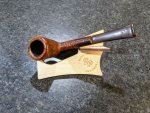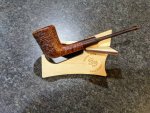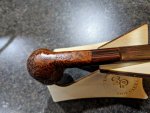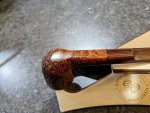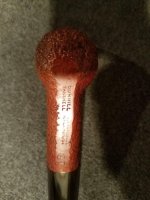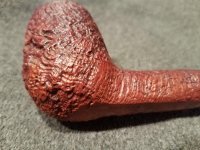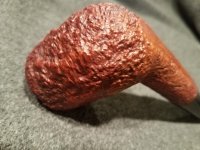Anyone noticed lately how many Dunhill/White Spots are listed with the English estate pipes on smoking pipes? A lot of pipe owners must be liquidating. The prices, however, are holding just fine. Ha!
Showoff Your Dunhill Pipes Here!
- Thread starter smokeybear
- Start date
You are using an out of date browser. It may not display this or other websites correctly.
You should upgrade or use an alternative browser.
You should upgrade or use an alternative browser.
SmokingPipes.com Updates
Watch for Updates Twice a Week
Very possibly 1951. One of the fun facts about Dunhills is that they can often be very precisely dated by their nomenclature, and this has been the subject of considerable study by various experts (including my own favorite, John Loring--who published a 75pp book devoted to nothing else).Thanks for the info. Now i know that its from the 50s era.
This said, your pipe poses a bit of a mystery.
If I am reading Loring correctly, and assuming your seemingly clear scans of what appears to be well-stamped nomenclature aren't obscuring it, normally one would expect to find a tiny single digit number underlined with a minuscule bar (normally next to the "D" of "Made in England").
On the other hand, it has both the patent number for a "spring flange inner tube" and the pipe's shape size in a circle (followed by an R). So, the earliest date it could be is 1951. And the latest date it could be is 1952, when the word London was replaced by "Root Briar."
According to Loring, there never was a "1" stamp at the factory for 1951 and they continued stamping pipes with a "0." Loring also claims that no pipe from 1951 has ever been seen with a "1." Likely, way more than you want to know, and others might have a different theory or date. But hey, it really is a very nice pipe.
A Small a.k.a “Pocket” Dunhill Bent Shell Magnum—Stumbled on in the Wild & Returned to Pristine, Time-Machine Perfection by George Dibos
After more than twenty years of Ebay hunting, variously for books, vintage Japanese fountain pens, french grand hotel ashtrays, Reutter-Atmos and industrial clocks, mid-century stainless steel medical furniture, randonneur bicycle components, and oh yes, English briar pipes— most often older Dunhills, I’ve had my fair share of adventures, disappointments, minor tragedies, lucky and even quite extraordinarily lucky finds, bargains, and occasional experiences of buyers’ remorse. I’ve also made my peace with the endlessly annoying changing rules of the 21st century’s 24-hour global virtual successor to the flea market—and its profound effect on its analog antecedents, once so vibrant a part of London, Amsterdam, Vienna and New York when I was lucky enough to visit or live there. But of my 1500 Ebay transactions (and all that preceded them), I can’t say anything quite compares to the pipe purchase I made at the end of May—which, as it happens, was my first pipe in nearly a dozen years.
For anyone here, who might be interested in a fairly detailed account of events, an interminably long almost novel-length post follows this one. My sincere apologies to everyone else—who can quickly skip directly below to my two amateurish pictures, and ignore my continuation of the story in the next post.
Or better yet, you can go instead to go to George Dibos remarkably good photos—
And then, if interested, turn to George’s 5-part YouTube video about his “invisible” shank repair to see one of his most miraculous repair/restoration efforts ever. Anyone familiar with George’s museum quality conservation work, will think this an exaggeration. But I assure you, it’s not. George’s work is generally the best there is. But on this occasion, if you’ve ever read the lives of Saints, George’s effort was in the something of the same league as Their impossible feats of healing, only his involved a pipe.
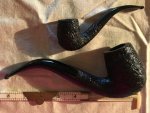

After more than twenty years of Ebay hunting, variously for books, vintage Japanese fountain pens, french grand hotel ashtrays, Reutter-Atmos and industrial clocks, mid-century stainless steel medical furniture, randonneur bicycle components, and oh yes, English briar pipes— most often older Dunhills, I’ve had my fair share of adventures, disappointments, minor tragedies, lucky and even quite extraordinarily lucky finds, bargains, and occasional experiences of buyers’ remorse. I’ve also made my peace with the endlessly annoying changing rules of the 21st century’s 24-hour global virtual successor to the flea market—and its profound effect on its analog antecedents, once so vibrant a part of London, Amsterdam, Vienna and New York when I was lucky enough to visit or live there. But of my 1500 Ebay transactions (and all that preceded them), I can’t say anything quite compares to the pipe purchase I made at the end of May—which, as it happens, was my first pipe in nearly a dozen years.
For anyone here, who might be interested in a fairly detailed account of events, an interminably long almost novel-length post follows this one. My sincere apologies to everyone else—who can quickly skip directly below to my two amateurish pictures, and ignore my continuation of the story in the next post.
Or better yet, you can go instead to go to George Dibos remarkably good photos—
And then, if interested, turn to George’s 5-part YouTube video about his “invisible” shank repair to see one of his most miraculous repair/restoration efforts ever. Anyone familiar with George’s museum quality conservation work, will think this an exaggeration. But I assure you, it’s not. George’s work is generally the best there is. But on this occasion, if you’ve ever read the lives of Saints, George’s effort was in the something of the same league as Their impossible feats of healing, only his involved a pipe.


A Small a.k.a “Pocket” Dunhill Bent Shell Magnum (continued)
In any event--for anyone who may still be with me, I told myself one Sunday morning, roughly a month ago, that a little window-shopping over my morning espresso wouldn’t hurt— even if, despite my best intentions, what can end up happening too often suggests Oscar Wilde’s dictum, “I can resist anything. . . except temptation.”
In this case, what attracted my bemused attention (like a tug on a water dowser’s forked stick) was a somewhat garbled, misspelt title (accompanied by no additional description, but a few decent quality photographs)—
“Dunhill shell priar part number119708/176 in used condition”
Some of the time this sort of thing is just honest ignorance; while on other occasions, when not outright fraud, it can imply a certain amount of guile. In this instance, other than the final digit turning out to be a five (and not a six) what little was there felt instinctively okay, and ultimately proved accurate enough. Indeed—to skip ahead—as I would later find out, the seller really did know nothing whatsoever about pipes in general, nor this one in particular, other than she’d found it at a “house clearance,” somewhere near Brighton, England, where she lived, and really could tell me nothing more about it or its “provenance.”
What was rather of more immediate concern was whether she’d be willing to ship to the US. And since the pipe had been listed perhaps an hour earlier—as an auction with a minimum opening bid of £50 as well as the option of making an “offer”—I quickly sent her a message on both subjects.
She wrote back, “I would post to us,” and so, I figured what the heck— and made with what seemed to me a fair-minded offer for what I took to be a completely unrestored group 3-4 sized Dunhill Shell bent, with particularly crisp nomenclature, a stem without any sign of oxidation, and a blast of unusually expressive character. By all appearances in shape, it was part of a family of related Dunhill models I particularly like. Definitely not the legendary LC or the graceful 120—and its bowl looked to me a tad too short and just a bit too stout to be a 56— but I thought even if it turned out to be a comparatively modest mid-1920s 53, that would be acceptable.
There was no obvious damage (although that’s a risk of the game, and one tries to figure the possibility in calculating what you decide you is reasonable to spend). Only what seemed to be the sort of bumps and scraps of comparatively benign and long neglect. And exactly what you might expect a forgotten pipe would suffer after being at the back of a cluttered drawer for a few decades.
The only mystery that nagged at me was that there really didn’t seem to be a shape number stamped anywhere.
But in the mid-1920s, at least according to John Loring, nomenclature errors and omission were not entirely unknown. And if the 1926 Export Edition of About Smoke (and the 1927 edition that followed) are to be believed, Dunhill shells of the time ought to have been stamped with roman numerals—although there is enough ambiguity in the catalogues’ sales prose to suggest that roman numerals weren’t necessarily about nomenclature stamping at all, and that at least early on (in contrast to smooth finish models), Dunhill’s original marketing idea (rapidly abandoned) was that every shell pipe should be a unique individual, unless the customer asked it conform to a catalogue shape.
The next problem, it seemed, when the seller responded only a few minutes after I placed my offer, was she said she’d gotten another offer from a rival potential buyer for exactly the same amount. Could I do better? I added 10%. And the deal was done.
A PayPal invoice followed. I gave her directions about packing, insisted on tracking, and my “Shell Priar” was in the the mail the following morning.
Almost instantly the package disappeared for the next three weeks from one of Europe’s worst international postal processing hubs, before finally appearing in a scan at Elk Grove, Illinois (of all places).
Meanwhile, to pass the time (and quiet my anxiety it might be lost), I studied the listing’s photos for some hint of scale, and/or any sign that a shape number had been somehow erased. But scale’s a fairly tricky and common problem with online transactions, and really, how much smaller than a size 3 was it likely to be?
I suppose I might have asked the seller for specifics, but she really didn’t seem to know or have noticed anything more about the “Priar” than she did about her signed Teddy Bear painting, an antique Chinese teacup saucer, a Stanley Tool staple gun, two Royal Salute blended whiskey corks, or the vintage NASCAR playstation game. It was to her no different than a hundred other very miscellaneous “items” she listed for sale each month.
Finally, to my great relief, the package arrived.
The generous use of bubble wrap was reassuring. But there was little hint of what I was unwrapping until voila!— and I found myself holding an absolutely gargantuan, beautifully proportioned, jet black stem.
Over the next couple of hours, it was all rather like a segment of the “Antiques Road Show”—but one in which I got to play all the different characters. So Not a 53, 56, 120 or LC. That I knew instantly, but what (or more like it, WTF!!!)? Once the pipe was assembled—it seemed astonishing.
It didn’t take me before before I found myself gazing at what appeared to be my new Dunhill’s fraternal twin. This in a photograph I’d studied and admired occasionally for nearly fifteen years—that of the “1925 Dunhill Shell Small Magnum” in John Loring’s collection. But could this possibly be so?
Out of some 250,000 pipes Dunhill made annually during the period 1921/22-1939, according to Loring, perhaps 200 magnums of various shapes and sizes had been produced. Of these, perhaps five “pocket magnums” were known to still exist (out of a total figure of roughly 50—some 38 recorded by Rich Esserman in a 1999 census he published in the “35th Anniversary” issue of the “Pipe Smokers Ephemeris,” and perhaps ten discovered since).
The best idea, it seemed to me, was to get a second opinion from an old friend who’d once run the internet’s most elegant online vintage pipe shop that had consistently done a brisk business in very high end and costly pre-war Dunhills.
“Is it at least eight inches?” was he most wanted to know. (A somewhat loaded question (so phrased)—recalling drunken first dates with future girlfriends in a less enlightened era, long ago.)
This actually took me some time to answer accurately, since measuring pipes for resale or any other purpose had never much concerned me. But yes. 8.125.” With a bowl 2.75” tall.
That was the good news. Utterly amazingly good news.
The seriously bad news, however, was that the shank had two nasty cracks that looked nastier the more closely one examined them in strong light. And at least to me, this was clearly not an occasion for superglue and rubber bands.
Alternatively, I could muster much enthusiasm for the idea of a conventional silver band repair—if there were any alternative. Nor did I find in any way appealing the prospect of the pipe existing in perpetual future limbo gathering dust in a trophy case or as a lawn ornament. I suppose I could have worn it on a gold chain as part of my costume at a pipe show as an icebreaking conversation starter with strangers. But really, these were all terrible, rather sad possible answers to what to do.
And so, on bended knee I wrote to GeorgeD the same night to ask if he might find the clearly formidable challenge intriguing, and the pipe worthy of his ministrations. And the next day, my magnum was on its way to Kansas City.
The bottom line, of George’s assessment was very cautious, carefully qualified optimism that a decent outcome was far from unlikely. At least IF pretty much everything fell into place, and the stars were aligned. On the other hand, a not insignificant risk was that the shank might shatter into several pizza shaped wedges. And it was very much my call. The only possible answer, at least for me, was to take the gamble. This, even before George had finished his sentence.
The final result (and the heroic lengths to which George went, following meticulous diagnostics, preparation, and planning, as can be seen on George’s YouTube channel as linked above) reached me safely on Tuesday afternoon.
Maybe not quite in the same league as finding Vermeer’s “The Concert” (stolen from the Isabella Stewart Gardner in Boston in 1990), nor the missing Amber Room from the Catherine Palace of Tsarskoye Selo. But an especially well-carved “pocket magnum” has now been added to the tally of known survivors. And I am in awe, far from convinced I in any way deserve quite so magnificent an object. But delighted that the fates have entrusted me to be its steward for some years to come.
And so, once again, I am telling myself, no more pipes (even if no particular harm can come from an occasional hour of window shopping). And trying to find the courage (and likely the better part of an entire afternoon) to fill the bowl with tobacco and actually smoke it. Thank you, George! Thank you!
In any event--for anyone who may still be with me, I told myself one Sunday morning, roughly a month ago, that a little window-shopping over my morning espresso wouldn’t hurt— even if, despite my best intentions, what can end up happening too often suggests Oscar Wilde’s dictum, “I can resist anything. . . except temptation.”
In this case, what attracted my bemused attention (like a tug on a water dowser’s forked stick) was a somewhat garbled, misspelt title (accompanied by no additional description, but a few decent quality photographs)—
“Dunhill shell priar part number119708/176 in used condition”
Some of the time this sort of thing is just honest ignorance; while on other occasions, when not outright fraud, it can imply a certain amount of guile. In this instance, other than the final digit turning out to be a five (and not a six) what little was there felt instinctively okay, and ultimately proved accurate enough. Indeed—to skip ahead—as I would later find out, the seller really did know nothing whatsoever about pipes in general, nor this one in particular, other than she’d found it at a “house clearance,” somewhere near Brighton, England, where she lived, and really could tell me nothing more about it or its “provenance.”
What was rather of more immediate concern was whether she’d be willing to ship to the US. And since the pipe had been listed perhaps an hour earlier—as an auction with a minimum opening bid of £50 as well as the option of making an “offer”—I quickly sent her a message on both subjects.
She wrote back, “I would post to us,” and so, I figured what the heck— and made with what seemed to me a fair-minded offer for what I took to be a completely unrestored group 3-4 sized Dunhill Shell bent, with particularly crisp nomenclature, a stem without any sign of oxidation, and a blast of unusually expressive character. By all appearances in shape, it was part of a family of related Dunhill models I particularly like. Definitely not the legendary LC or the graceful 120—and its bowl looked to me a tad too short and just a bit too stout to be a 56— but I thought even if it turned out to be a comparatively modest mid-1920s 53, that would be acceptable.
There was no obvious damage (although that’s a risk of the game, and one tries to figure the possibility in calculating what you decide you is reasonable to spend). Only what seemed to be the sort of bumps and scraps of comparatively benign and long neglect. And exactly what you might expect a forgotten pipe would suffer after being at the back of a cluttered drawer for a few decades.
The only mystery that nagged at me was that there really didn’t seem to be a shape number stamped anywhere.
But in the mid-1920s, at least according to John Loring, nomenclature errors and omission were not entirely unknown. And if the 1926 Export Edition of About Smoke (and the 1927 edition that followed) are to be believed, Dunhill shells of the time ought to have been stamped with roman numerals—although there is enough ambiguity in the catalogues’ sales prose to suggest that roman numerals weren’t necessarily about nomenclature stamping at all, and that at least early on (in contrast to smooth finish models), Dunhill’s original marketing idea (rapidly abandoned) was that every shell pipe should be a unique individual, unless the customer asked it conform to a catalogue shape.
The next problem, it seemed, when the seller responded only a few minutes after I placed my offer, was she said she’d gotten another offer from a rival potential buyer for exactly the same amount. Could I do better? I added 10%. And the deal was done.
A PayPal invoice followed. I gave her directions about packing, insisted on tracking, and my “Shell Priar” was in the the mail the following morning.
Almost instantly the package disappeared for the next three weeks from one of Europe’s worst international postal processing hubs, before finally appearing in a scan at Elk Grove, Illinois (of all places).
Meanwhile, to pass the time (and quiet my anxiety it might be lost), I studied the listing’s photos for some hint of scale, and/or any sign that a shape number had been somehow erased. But scale’s a fairly tricky and common problem with online transactions, and really, how much smaller than a size 3 was it likely to be?
I suppose I might have asked the seller for specifics, but she really didn’t seem to know or have noticed anything more about the “Priar” than she did about her signed Teddy Bear painting, an antique Chinese teacup saucer, a Stanley Tool staple gun, two Royal Salute blended whiskey corks, or the vintage NASCAR playstation game. It was to her no different than a hundred other very miscellaneous “items” she listed for sale each month.
Finally, to my great relief, the package arrived.
The generous use of bubble wrap was reassuring. But there was little hint of what I was unwrapping until voila!— and I found myself holding an absolutely gargantuan, beautifully proportioned, jet black stem.
Over the next couple of hours, it was all rather like a segment of the “Antiques Road Show”—but one in which I got to play all the different characters. So Not a 53, 56, 120 or LC. That I knew instantly, but what (or more like it, WTF!!!)? Once the pipe was assembled—it seemed astonishing.
It didn’t take me before before I found myself gazing at what appeared to be my new Dunhill’s fraternal twin. This in a photograph I’d studied and admired occasionally for nearly fifteen years—that of the “1925 Dunhill Shell Small Magnum” in John Loring’s collection. But could this possibly be so?
Out of some 250,000 pipes Dunhill made annually during the period 1921/22-1939, according to Loring, perhaps 200 magnums of various shapes and sizes had been produced. Of these, perhaps five “pocket magnums” were known to still exist (out of a total figure of roughly 50—some 38 recorded by Rich Esserman in a 1999 census he published in the “35th Anniversary” issue of the “Pipe Smokers Ephemeris,” and perhaps ten discovered since).
The best idea, it seemed to me, was to get a second opinion from an old friend who’d once run the internet’s most elegant online vintage pipe shop that had consistently done a brisk business in very high end and costly pre-war Dunhills.
“Is it at least eight inches?” was he most wanted to know. (A somewhat loaded question (so phrased)—recalling drunken first dates with future girlfriends in a less enlightened era, long ago.)
This actually took me some time to answer accurately, since measuring pipes for resale or any other purpose had never much concerned me. But yes. 8.125.” With a bowl 2.75” tall.
That was the good news. Utterly amazingly good news.
The seriously bad news, however, was that the shank had two nasty cracks that looked nastier the more closely one examined them in strong light. And at least to me, this was clearly not an occasion for superglue and rubber bands.
Alternatively, I could muster much enthusiasm for the idea of a conventional silver band repair—if there were any alternative. Nor did I find in any way appealing the prospect of the pipe existing in perpetual future limbo gathering dust in a trophy case or as a lawn ornament. I suppose I could have worn it on a gold chain as part of my costume at a pipe show as an icebreaking conversation starter with strangers. But really, these were all terrible, rather sad possible answers to what to do.
And so, on bended knee I wrote to GeorgeD the same night to ask if he might find the clearly formidable challenge intriguing, and the pipe worthy of his ministrations. And the next day, my magnum was on its way to Kansas City.
The bottom line, of George’s assessment was very cautious, carefully qualified optimism that a decent outcome was far from unlikely. At least IF pretty much everything fell into place, and the stars were aligned. On the other hand, a not insignificant risk was that the shank might shatter into several pizza shaped wedges. And it was very much my call. The only possible answer, at least for me, was to take the gamble. This, even before George had finished his sentence.
The final result (and the heroic lengths to which George went, following meticulous diagnostics, preparation, and planning, as can be seen on George’s YouTube channel as linked above) reached me safely on Tuesday afternoon.
Maybe not quite in the same league as finding Vermeer’s “The Concert” (stolen from the Isabella Stewart Gardner in Boston in 1990), nor the missing Amber Room from the Catherine Palace of Tsarskoye Selo. But an especially well-carved “pocket magnum” has now been added to the tally of known survivors. And I am in awe, far from convinced I in any way deserve quite so magnificent an object. But delighted that the fates have entrusted me to be its steward for some years to come.
And so, once again, I am telling myself, no more pipes (even if no particular harm can come from an occasional hour of window shopping). And trying to find the courage (and likely the better part of an entire afternoon) to fill the bowl with tobacco and actually smoke it. Thank you, George! Thank you!
A Small a.k.a “Pocket” Dunhill Bent Shell Magnum (continued)
In any event--for anyone who may still be with me, I told myself one Sunday morning, roughly a month ago, that a little window-shopping over my morning espresso wouldn’t hurt— even if, despite my best intentions, what can end up happening too often suggests Oscar Wilde’s dictum, “I can resist anything. . . except temptation.”
In this case, what attracted my bemused attention (like a tug on a water dowser’s forked stick) was a somewhat garbled, misspelt title (accompanied by no additional description, but a few decent quality photographs)—
“Dunhill shell priar part number119708/176 in used condition”
Some of the time this sort of thing is just honest ignorance; while on other occasions, when not outright fraud, it can imply a certain amount of guile. In this instance, other than the final digit turning out to be a five (and not a six) what little was there felt instinctively okay, and ultimately proved accurate enough. Indeed—to skip ahead—as I would later find out, the seller really did know nothing whatsoever about pipes in general, nor this one in particular, other than she’d found it at a “house clearance,” somewhere near Brighton, England, where she lived, and really could tell me nothing more about it or its “provenance.”
What was rather of more immediate concern was whether she’d be willing to ship to the US. And since the pipe had been listed perhaps an hour earlier—as an auction with a minimum opening bid of £50 as well as the option of making an “offer”—I quickly sent her a message on both subjects.
She wrote back, “I would post to us,” and so, I figured what the heck— and made with what seemed to me a fair-minded offer for what I took to be a completely unrestored group 3-4 sized Dunhill Shell bent, with particularly crisp nomenclature, a stem without any sign of oxidation, and a blast of unusually expressive character. By all appearances in shape, it was part of a family of related Dunhill models I particularly like. Definitely not the legendary LC or the graceful 120—and its bowl looked to me a tad too short and just a bit too stout to be a 56— but I thought even if it turned out to be a comparatively modest mid-1920s 53, that would be acceptable.
There was no obvious damage (although that’s a risk of the game, and one tries to figure the possibility in calculating what you decide you is reasonable to spend). Only what seemed to be the sort of bumps and scraps of comparatively benign and long neglect. And exactly what you might expect a forgotten pipe would suffer after being at the back of a cluttered drawer for a few decades.
The only mystery that nagged at me was that there really didn’t seem to be a shape number stamped anywhere.
The next problem, it seemed, when the seller responded only a few minutes after I placed my offer, was she said she’d gotten another offer from a rival potential buyer for exactly the same amount. Could I do better? I added 10%. And the deal was done.
A PayPal invoice followed. I gave her directions about packing, insisted on tracking, and my “Shell Priar” was in the the mail the following morning.
Almost instantly the package disappeared for the next three weeks from one of Europe’s worst international postal processing hubs, before finally appearing in a scan at Elk Grove, Illinois (of all places).
Meanwhile, to pass the time (and quiet my anxiety it might be lost), I studied the listing’s photos for some hint of scale, and/or any sign that a shape number had been somehow erased. But scale’s a fairly tricky and common problem with online transactions, and really, how much smaller than a size 3 was it likely to be?
I suppose I might have asked the seller for specifics, but she really didn’t seem to know or have noticed anything more about the “Priar” than she did about her signed Teddy Bear painting, an antique Chinese teacup saucer, a Stanley Tool staple gun, two Royal Salute blended whiskey corks, or the vintage NASCAR playstation game. It was to her no different than a hundred other very miscellaneous “items” she listed for sale each month.
Finally, to my great relief, the package arrived.
Out of some 250,000 pipes Dunhill made annually during the period 1921/22-1939, according to Loring, perhaps 200 magnums of various shapes and sizes had been produced. Of these, perhaps five “pocket magnums” were known to still exist (out of a total figure of roughly 50—some 38 recorded by Rich Esserman in a 1999 census he published in the “35th Anniversary” issue of the “Pipe Smokers Ephemeris,” and perhaps ten discovered since).
“Is it at least eight inches?” was he most wanted to know. (A somewhat loaded question (so phrased)—recalling drunken first dates with future girlfriends in a less enlightened era, long ago.)
This actually took me some time to answer accurately, since measuring pipes for resale or any other purpose had never much concerned me. But yes. 8.125.” With a bowl 2.75” tall.
That was the good news. Utterly amazingly good news.
The seriously bad news, however, was that the shank had two nasty cracks that looked nastier the more closely one examined them in strong light. And at least to me, this was clearly not an occasion for superglue and rubber bands.
And so, on bended knee I wrote to GeorgeD the same night to ask if he might find the clearly formidable challenge intriguing, and the pipe worthy of his ministrations. And the next day, my magnum was on its way to Kansas City.
The bottom line, of George’s assessment was very cautious, carefully qualified optimism that a decent outcome was far from unlikely. At least IF pretty much everything fell into place, and the stars were aligned. On the other hand, a not insignificant risk was that the shank might shatter into several pizza shaped wedges. And it was very much my call. The only possible answer, at least for me, was to take the gamble. This, even before George had finished his sentence.
The final result (and the heroic lengths to which George went, following meticulous diagnostics, preparation, and planning, as can be seen on George’s YouTube channel as linked above) reached me safely on Tuesday afternoon.
Maybe not quite in the same league as finding Vermeer’s “The Concert” (stolen from the Isabella Stewart Gardner in Boston in 1990), nor the missing Amber Room from the Catherine Palace of Tsarskoye Selo. But an especially well-carved “pocket magnum” has now been added to the tally of known survivors. And I am in awe, far from convinced I in any way deserve quite so magnificent an object. But delighted that the fates have entrusted me to be its steward for some years to come.
And so, once again, I am telling myself, no more pipes (even if no particular harm can come from an occasional hour of window shopping). And trying to find the courage (and likely the better part of an entire afternoon) to fill the bowl with tobacco and actually smoke it. Thank you, George! Thank you!
With apologies, quote shortened to allow word count for a reply.
Guy,
Thank you for recounting this tale of mystery and international intrigue, of loss and resurrection. I enjoyed every word of it.
I especially enjoyed your recounting of your interactions with the seller and your surprise when your modest pipe proved to be of Brobdingnagian proportions. I had a similar experience with the first Barling Quaint that I purchased. The treachery of images.
Congratulations on this new addition to your collection and to GeorgeD, whose wizardry never ceases to amaze me.
George has taken scraps of kindling and slobbered on accidental chew toys and returned them to pristine condition, not only cosmetically, but more importantly, structurally. This underscores what I've posted elsewhere. There is a huge difference in the skills and artistry of a restorer like George and your standard pipe repair. They are not one and the same. Cleaning up a pipe isn't the same thing as restoring it.
Well said!George has taken scraps of kindling and slobbered on accidental chew toys and returned them to pristine condition, not only cosmetically, but more importantly, structurally. This underscores what I've posted elsewhere. There is a huge difference in the skills and artistry of a restorer like George and your standard pipe repair. They are not one and the same. Cleaning up a pipe isn't the same thing as restoring it.
Well, now.
The number of stars that had to align just so for the Great Dunhill Mini-Mag Adventure of 2020 to happen is unknown, but I guarantee it was a bunch of 'em.
Nothing much I can add to the tech particulars that wasn't covered by the video or the pics on Pipemakers Forum, so I won't try.
And nothing to add to guylesss's (!) account of the scope of things from a collector / owner's perspective. Besides being comprehensive, he writes like a national-class professional. (Oh, that's right, he is. lol Not kidding, look it up)
I guess the only way I can add anything is to use the occasion to answer a question I get asked from time to time about why I'm driven to do this crazy thing called collectable grade repair. If I fixed damaged million dollar paintings or priceless stauary or something, people would understand. But pipes? Let's just say aren't sold at Sotheby's or Christie's because the most valuable pipe on Earth wouldn't bring enough to cover the seller's fees.
People collect them and smoke them almost exclusively out of passion.
And THEIR passion drives MINE.
The end.
Once in a while a long-odds-at-every-turn chain of events comes together just so, and a story like the Great Dunhill Mini-Mag Adventure of 2020 is the result.
Hoping that any given day might bring another is why I wake up in the morning.
---
PS --- Anyone here have a connection to the NASPC? Guy's account seems exactly like the sort of thing they'd want to put in their newsletter.
The number of stars that had to align just so for the Great Dunhill Mini-Mag Adventure of 2020 to happen is unknown, but I guarantee it was a bunch of 'em.
Nothing much I can add to the tech particulars that wasn't covered by the video or the pics on Pipemakers Forum, so I won't try.
And nothing to add to guylesss's (!) account of the scope of things from a collector / owner's perspective. Besides being comprehensive, he writes like a national-class professional. (Oh, that's right, he is. lol Not kidding, look it up)
I guess the only way I can add anything is to use the occasion to answer a question I get asked from time to time about why I'm driven to do this crazy thing called collectable grade repair. If I fixed damaged million dollar paintings or priceless stauary or something, people would understand. But pipes? Let's just say aren't sold at Sotheby's or Christie's because the most valuable pipe on Earth wouldn't bring enough to cover the seller's fees.
People collect them and smoke them almost exclusively out of passion.
And THEIR passion drives MINE.
The end.
Once in a while a long-odds-at-every-turn chain of events comes together just so, and a story like the Great Dunhill Mini-Mag Adventure of 2020 is the result.
Hoping that any given day might bring another is why I wake up in the morning.
---
PS --- Anyone here have a connection to the NASPC? Guy's account seems exactly like the sort of thing they'd want to put in their newsletter.
Articles for The Pipe Collector can be submitted by emailing them to PipeCollector@graphictouch.biz. They don't seem to do anything with regard to resizing photos, BTW. So the first couple of times I had an article in it, my ugly mug took up a quarter of the page.PS --- Anyone here have a connection to the NASPC? Guy's account seems exactly like the sort of thing they'd want to put in their newsletter.
I was just speaking today with a regular contributor to The Pipe Collector. It turns out that Guylesss' pipe is going to be featured in an article soon.Articles for The Pipe Collector can be submitted by emailing them to PipeCollector@graphictouch.biz. They don't seem to do anything with regard to resizing photos, BTW. So the first couple of times I had an article in it, my ugly mug took up a quarter of the page.
News to me--perhaps they'd be amenable to my reaching out for a few details. Much appreciate, @craiginthecorn, both the heads up and the email for submissions above.I was just speaking today with a regular contributor to The Pipe Collector. It turns out that Guylesss' pipe is going to be featured in an article soon.
Dunhill Unicorn or Dunhill Failacorn?
Okay my wiser Brothers of the Pipe, tell me if I landed an extraordinary briar or no. You can see the stamping. Seems to be a '79 group 6. No other numbers because...it's a quaint? I have been unable to find any other Dunhills out there close to this shape. I need you all to tell me it was an exceptional buy, brilliant investment, perfectly sensible purchase. Then I'm going to tell my wife.
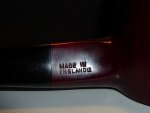
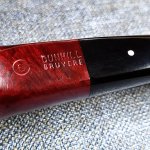
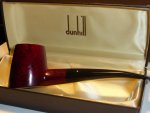
Okay my wiser Brothers of the Pipe, tell me if I landed an extraordinary briar or no. You can see the stamping. Seems to be a '79 group 6. No other numbers because...it's a quaint? I have been unable to find any other Dunhills out there close to this shape. I need you all to tell me it was an exceptional buy, brilliant investment, perfectly sensible purchase. Then I'm going to tell my wife.



Attachments
I agree. The name "Dunhill" awakens an ungodly allegiance, all from whatever it was that Alfred did in the early 20th century, parallel to the height of the English Empire. What amazes me is that it continues full-force even now. At the same time as the conclusion on the forums is the above, smokers will collect Dunhills in by far and away the largest numbers, and threads such as this continue for 18 pages. Is there any other brand that does this? Not even close.I have several I got some years ago. Kind of a fad thing...
Not a big Dunghill fan.
Overpriced, overhyped machine made pipes, IMHO.
I had a patent, and it smoked as well as but no better than any other pipe; but then again to me all pipes smoke the same. By this I admit that I am a troglodyte, in addition to not being a carver, and thus should not voice any opinions about pipes, notwithstanding that I smoked pipes for 16 years.
I do apologize.
I didn't think I did too bad!! Some light teeth marks in the stem there, but other than that it appears to be in great shape! It does have some cake that I want to remove. Just waiting on a kleen reem to arrive!Excellent value!
Nice, elegant shape you found there ... going by the numbers it's aJust scored this estate 32051 for 58.00. It was said to be a 1980 Dunhill Cumberland.
My first Dunhill this time around.
View attachment 48521
View attachment 48522
View attachment 48523
View attachment 48524
View attachment 48525
3 - Group 3 bowl size
2 - Saddle mouthpiece
05 - Dublin shape
1- Straight
3/2/05/1
Noting this thread has been dormant for some time, I thought this photo-post might cause it to stir and perhaps awake.
1954 Tanshell showing just a wonderfully deep and figured blast. I just love this pipe; and it was almost perfect, with original inner tube. However, it had been hardly smoked at all, so I have not yet been able to bring myself to smoke it.
1954 Tanshell showing just a wonderfully deep and figured blast. I just love this pipe; and it was almost perfect, with original inner tube. However, it had been hardly smoked at all, so I have not yet been able to bring myself to smoke it.









